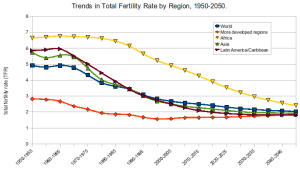The number of European countries at or above replacement level is. The crude death rate exceeds the crude birth rate.

The Human Population Environmental Science
B Improve economic opportunities for women C Distribute birth control devices.

. MM Excluding migration a country or region will achieve ZPG zero population growth when it has. A rising b falling c staying about the same d influenced by precipitation levels answer b falling. The physical location of a place using the Earth latitude-longitude grid is properly called the.
The arithmetic density of population for a country is determined by dividing the total. For example a fertility rate of 16 means that a. Are influenced by precipitation levels.
Almost everywhere on Earth Total Fertility Rates TFRs are. Almost everywhere on Earth Total Fertility Rates TFRs are a rising. C staying about the same.
D Reduce infant and child mortality. In the Western Hemisphere TFRs fell below replacement level before 1989 in. C are staying about the same.
This meant that in 1750 the doubling time was on the order of 150. Almost everywhere on Earth Total Fertility Rates TFRs are. In the Western Hemisphere total fertility rates fell below replacement level before 1989 in.
In the Western Hemisphere Total Fertility Rates fell below replacement level before 1989 in ____. Almost everywhere on Earth Total Fertility Rates TFRs. This is primarily because a high percentage of the population is.
Almost everywhere on Earth Total Fertility Rates TFRs are rising. Absolute location _____ culture is conceived as small incorporating a homogeneous population typically rural and cohesive in cultural traits. Up to 24 cash back 3.
A crude birth rate of 10. C staying about the same. The general fertility rate was 558 births per 1000 women ages 15 to 44 reaching yet another record low according to the provisional data.
The United States Canada and Cuba. Staying about the same. TFR is measured by adding the age-specific rates at a point in time and changes over time as well as geographically.
E All of the above. Despite this some regions are still experience significant population growthThe UN noted for example that despite lower fertility rates in Africa where rates fell from 51 births per woman between 2000-2005 to 47 births between 2010-2015 the populations of 26 African countries are likely to at least double by 2050. 1 1 pts Question 26 The arithmetic density of population for a country is determined by dividing the total population by the number of farmers.
A Keep girls in school longer. Almost everywhere on Earth Total Fertility Rates TFRs are. Before 1750 death rates in Europe probably averaged 35 per 1000 but by 1850 the death rate was about 16 per 1000.
Less dangerous than once thought. Almost everywhere on Earth Total Fertility Rates TFRs are rising. Total Fertility Rate is the average number of children a woman would have over her reproductive lifetime 15 49 if she had the same age-specific fertility rates as other women throughout that period.
D influenced by precipitation levels. A rising. In the Western Hemisphere Total Fertility Rates fell below replacement level before 1989 in ____.
Almost everywhere on Earth Total Fertility Rates TFRs are. Population by the total area. Almost everywhere on Earth Total Fertility Rates TFRs A are rising.
C are staying. A rising b falling c staying about the same d influenced by precipitation levels. D influenced by precipitation levels.
When Ehrlich published his alarm the average woman had 492 births in her life total fertility rate. Staying about the same. Almost everywhere on Earth Total Fertility Rates TFRs are.
Are staying about the same. Replacement rate the number of births needed to keep a population at a stable level without immigration requires a total fertility of. Almost everywhere on earth total fertility rates TFR are.
Even though total fertility rates have been declining in some less - developed countries the total population has continued to grow. D influenced by precipitation levels. The Earth and humanity will survive as fertility rates fall almost everywhere.
The total fertility rate is the average number of children a woman gives birth to in their lifetime its different to the birth rate which is the. By 2018 the fertility rate had dropped by. Between 1650 and 1930 Earth s population increased by.
Total fertility rate which estimates how many babies a hypothetical group of 1000 women would have during their life based on data from a given year remains far below replacement. Folk Almost everywhere on Earth Total Fertility Rates TFRs are falling. B area of square miles by 5.
How can a country or region slow down its birth rates. D are influenced by precipitation levels. A the United States Canada and Cuba.
Almost everywhere on Earth Total Fertility Rates TFRs A are rising. 1 1 pts Question 25 Almost everywhere on Earth Total Fertility Rates TFRs are influenced by precipitation levels. B falling.
Almost everywhere on Earth Total Fertility Rates TFRs are. C staying about the same. The arithmetic density of population for a country is determined by dividing the total a population by the number of farmers.
Influenced by precipitation levels. B the United States and Argentina. C Canada and Mexico.

Fertility Rate An Overview Sciencedirect Topics

38 Maps That Explain The Global Economy Fertility Rate Human Overpopulation Total Fertility Rate

Pro Natal Policies Work But They Come With A Hefty Price Tag Institute For Family Studies
0 Comments